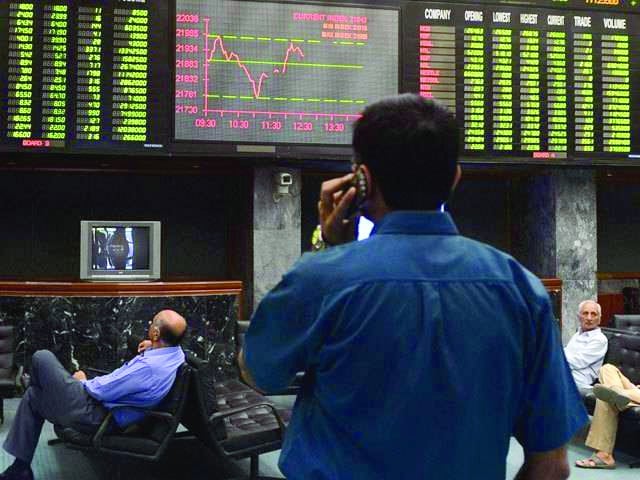
Will PSX spiral to 150,000?
”
KARACHI:
Hold your breath for a while. There are differing views over the country’s economic progress under the current government.
While government officials rightly point out improvements in certain indicators as signs of victory and stability after tumultuous years of firefighting, the majority remain unconvinced. Nonetheless, there is a very small segment of stock market investors who seem to be having a ball.
Although starting from a very low base, the broader KSE-100 index has seen astronomical returns, rising from 40,000 to nearly 120,000 points. The near 150-200% return of the index is creating mixed feelings in the country. If you ask certain investors, they would say their stock prices are far from their costs, while others will say they are in the green.
The past seven to eight years have shown mixed results for investors. Gold, US dollars and bank accounts have often outperformed the stock market since the 2017 MSCI Emerging Market peak.
However, some stocks have far outpaced the index returns, especially in sectors like pharmaceuticals, banking, fertilisers, oil and gas and autos. From the June 2023 lows, over 30 stocks have returned 200-300%, effectively tripling in value. But caution is needed; this rapid growth is unlikely to be sustainable in the long term.
Investors must remember that long-term returns of Pakistan’s equity market (PSX) tend to range between 15% and 25%, depending on the decade’s start and end points. These returns outperform the depreciation rate of the local currency, bank deposits, gold and real estate in many cases. Therefore, while past returns may seem attractive, they are not guaranteed to continue. Expectation management is critical.
That said, there are fundamental shifts in the equity capital markets that are worth noting:
Social media awareness: Platforms like WhatsApp, Twitter and increasing numbers of finfluencers have helped the stock market gain traction among local investors.
Digital accessibility: Affordable smartphones and internet have made it easier for people to open accounts digitally.
Real estate investment challenges: Small-ticket investors find it difficult to invest in real estate due to documentation and pricing issues, leading more funds into equities.
New IPOs: Initial public offerings (IPOs) have diversified investment options for those looking to deploy surplus cash.
The recent price-to-earnings (P/E) re-rating from 3.5x to over 6x is driven by several factors: the removal of default risks, IMF programme resumption, political stability, moderate oil prices, prudent fiscal and monetary policies and significant local liquidity seeking higher returns. The shift from fixed-income investments, which now offer returns below inflation, towards equities signals growing confidence in the market.
More investors now view the stock market not as a speculative gamble, but as a long-term wealth-building tool. The practice of monthly accumulation, starting from as little as Rs10,000, will help investors build a gradual, well-diversified portfolio over 10 to 20 years, providing a sustainable source of income alongside salaries or other income streams.
So, will the rally continue? The next two to three years show promise. With moderate oil prices, cyclical economic reversals, lower interest rates and structural reforms in critical sectors, Pakistan could see its index breach 150,000 in the next 18 to 24 months.
The key challenge remains to build investor trust, ensuring that the equity market is seen as a reliable wealth accumulation tool, not subject to speculative cycles.
The long-term P/E average for Pakistan has been 8x and with a 6-7% dividend yield, there is significant potential for growth. The next few years are crucial for developing this trust. It’s not too late to start investing, but thorough research and patience are key. Investors should remain realistic, avoid chasing quick returns and focus on building a stable, long-term portfolio.
Steps needed to build confidence
To sustain this growth, the government must take further steps to enhance market transparency and foster investor confidence:
Current account and export growth: Focus on maintaining less than 1% current account deficit by ensuring exports grow at a double-digit pace and moderate 4-5% rupee depreciation to avoid currency overvaluation and dollarisation.
Corporate governance reforms: Strengthen regulatory frameworks around corporate governance by ensuring stronger enforcement of financial disclosures and audit requirements. Insider trading and front-running should be treated as serious offences.
Tax reforms: Lower capital gains taxes and offer tax incentives to long-term investors. Reintroducing tax breaks for investment via mutual funds can further boost the market.
Minority shareholder protection: Provide greater protection for minority shareholders, which will encourage more retail participation in the market.
Corporate tax reductions: Reduce corporate taxes year-on-year for the next five years to provide clarity for investors and encourage new listings.
SME/Start-up listings: Encourage the listing of SMEs via the GEM (Growth Enterprise Market) board to broaden the market, offering investors higher-risk, higher-return opportunities.
These measures, combined with ongoing reforms, can ensure that Pakistan’s stock market remains an attractive and stable investment option for the years to come.
The writer is an independent economic analyst
”



